Recreating the Country blog |
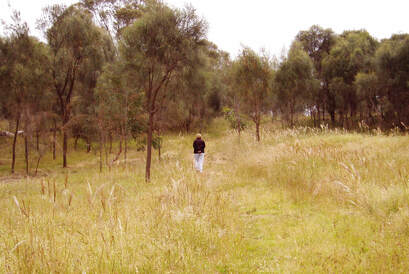 Dense communities of Drooping Sheoak in Teesdale Grassy Woodlands Reserve today Dense communities of Drooping Sheoak in Teesdale Grassy Woodlands Reserve today The phoenix rises from the ashes It’s May 2016 and the end of a long dry summer. I’m enjoying the view over a native grassland that was already showing tinges of green after our first decent rainfall in fourteen months. It was as if overnight the rain had washed away the layers of sun-bleached dust that had hidden their vibrant green. Beyond the grassland was the soft whispering edge of a woodland of Drooping Sheoaks, Allocasuarina verticillata. This woodland in Teesdale was described in 1853 by the Surveyor General A.J.Skene as ‘thickly wooded with sheoaks”. So you would be excused for thinking that not much had changed in 170 years. The confronting truth is that every Drooping Sheoak along with the gums and wattles were cleared from this reserve after settlement. There was a need for building materials and fire wood so the sheoaks, eucalypts and larger acacias were in demand. Even as recently as the early 1980’s, aerial photos show the reserve had very few trees. Two Council conducted cool burns in the 1980's and drought years of the 1990’s provided the perfect environment for a dry climate specialist like the Drooping Sheoak. An aerial photo taken at the end of this decade clearly shows clumps re-emerging. Today the recovery is complete and the Teesdale Grassy Woodlands Reserve is at least as thickly wooded as it was in 1853. 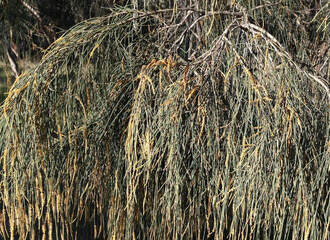 The hair-like branchlets of the Drooping Sheoak or 'Ngarri' The hair-like branchlets of the Drooping Sheoak or 'Ngarri' Commonly pronounced - Allo*cas*u*rina vertic*u*lata. The Wathaurong call the Drooping Sheoak ‘Ngarri’, which means hair tree. This beautifully describes the most recognisable feature of the tree which is its hair like foliage. Carolus Linnaeus, the father of taxonomy, was thinking along similar lines when he named the genus casuarina after the drooping feathers of the cassowary. He adapted the Malay word for a cassowary which is kasuari. More recently the Drooping Sheoak was reclassified and its botanical name changed from Casuarina to Allocasuarina. The Greek word 'Allos' - means 'different to'. 'verticillata' - refers to the vertical position of the scales (tiny leaves) on the weeping branchlets 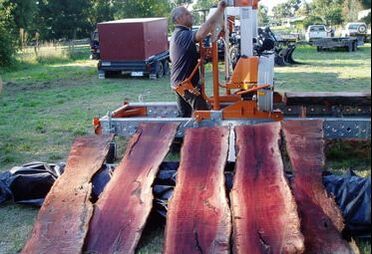 The beautiful rich red of Drooping Sheoak heartwood The beautiful rich red of Drooping Sheoak heartwood Getting to know Drooping Sheoaks A hardy small rounded tree to 7m that copes very well with dry and exposed sites. They have proven to be very adaptable to different soil types, as long as they are well drained. I have seen Drooping Sheoaks thriving on both heavy clay soils and well drained sandy loams. It's ability to fix atmospheric nitrogen also enables it to do very well on 'hungry' sandy soils. Note: For revegetation work it’s always recommended to match soil types. That is, choose plants grown from a provenance that has a similar soil type to the planting site. These plants are more likely to thrive. When they mature, branching usually starts at around 2m making them a useful small tree providing dappled shade for large gardens or a small paddock tree for the back paddock. Sheep also browse on the weeping ‘branchlets’ which provide useful drought fodder. It's hard dense timber is a deep red. When quarter sawn, distinct medullary rays crossing the growth rings are a beautiful and unique feature. A popular craft wood that polishes well, for turning, for wood art like sculptures and for furniture. It was also used by early settlers for roof shingles and fence palings Drooping Sheoaks are often seen as dense stands of trees on roadsides and in reserves. This is because they tend to dominate an area when they become established. Their dropped branchlets create a soft, thick carpet that prevents other tree seedlings from pushing through, though this takes decades to occur. This was the case at the Ocean Grove Nature Reserve where after a long absence of fire, both the Drooping and the Black Sheoak (A. littoralis - commonly pronounced lit*or*a*lis. This name means coastal and indicates that it's found mostly along the east coast of Australia) dominated at the expense of the local eucalypt species and the other understorey and shrub species. Recent cool burns have allowed a diversity of other plant species to re-establish. 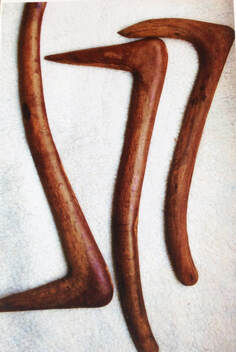 Boomerangs made from the roots of the Drooping Sheoak. Photo Neville Bonney Boomerangs made from the roots of the Drooping Sheoak. Photo Neville Bonney Traditional Owners Historic records suggest that Drooping Sheoaks were a prominent tree throughout the southern part of Australia before white settlement. This is because they were cultivated for their many values by the Traditional Owners. The timeless whispering of a soft breeze through their foliage adds a mysterious dimension to the tree. The Wathaurong word for this whispering sound is whit:ge:wherri, pronounced ‘witjweri’. To them this was the sound of their ancestor’s voices speaking to them - see the Dahl'wah story below. The Wathaurong soaked the cones of casuarinas in their drinking water to give it a lemon flavour and to add vitamin C. At times when water was scarce, they chewed the needle-like stems. This made their saliva flow and decreased the need to drink on long walks. Some sheoaks develop hollows in their trunks which trap water. To have a drink the Wathaurong would find a hollow tube to use as a straw or soak the water up with a ball of crushed grass. Drooping Sheoak wood is hard and ideal for making implements like spears, spear throwers, clubs, shields, digging sticks and clapping sticks. Returning boomerangs were carved from the roots, using the natural bends to advantage. 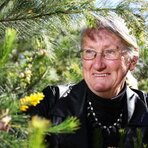 Frances Bodkin Frances Bodkin How Sheoaks came to be - a Dahl’wah story As told by Frances Bodkin, a D’harawal woman from Sydney. Aunty Fran is also a keeper and teacher of traditional Aboriginal knowledge and a western trained scientist with degrees in environmental science, geomorphology and climatology "Long ago men took responsibility for making string for hunting and fishing nets. They did this using plant fibres, twisted together by rubbing on their thighs. It was a difficult task, too difficult for women they claimed. But men were impatient, and felt they needed to do more important things like hunting and fishing. And besides, rubbing the fibres on their hairy legs was painful. Note from Frances Bodkin : Sheoaks don’t drop branches haphazardly like many Eucalypts so you can camp there any time. You don’t get snakes under Sheoaks. The leaf scales on the branchlets get under the scales on the belly of a snake. So they stay away making it a safe place" 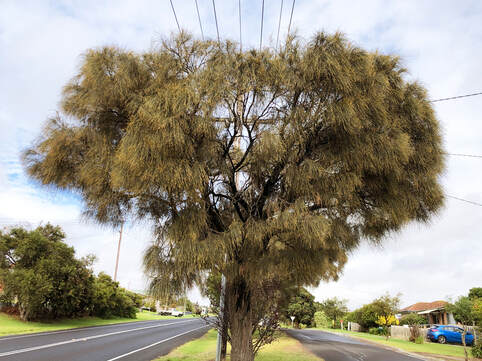 A male Drooping Sheoak flowering on the main road into Portarlington. Photo taken in late March. A male Drooping Sheoak flowering on the main road into Portarlington. Photo taken in late March. Nature notes This may be the first month of autumn, but for Drooping Sheoaks it could be ‘spring’. As you drive past a group of these trees you may notice many are turning yellow on their weeping tips. These are the male tree’s catkin flowers and they’re about to cast their pollen to the four winds. Using this shot-gun approach, male trees have to produce large amounts of pollen to chance on a female flower. And the competition for the males is pretty fierce. On my reckoning, there are usually about ten male trees for every one female. These aren’t good odds if you’re a male, keen for your DNA to be passed on to the next generation. Studies have shown that male pollen can amazingly travel up to 1km to pollinate a female flower. The female trees are very easy to spot as they are the sheoaks with cones. Starting as very small red flowers in autumn, they become shiny bronze cones after twelve months. The Drooping Sheoak has the largest cones of the sheoak family, some reaching the size of a bantam’s egg or a small Easter egg (Happy Easter!! and well done for getting this far). The seeds in the cones are relished by corellas and cockatoos. They are also an important food source for the endangered glossy black-cockatoo on Kangaroo Island. Small birds are often seen foraging for insects amongst the dense sheoak foliage. 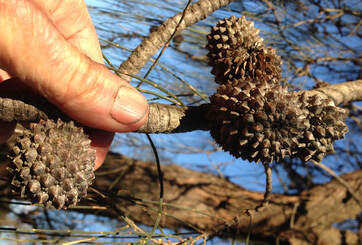 Mature cones on a female Drooping Sheoak Mature cones on a female Drooping Sheoak An unexpected evolution Puzzlingly, sheoaks were one of the new kids on the block in the Palaeocene, some 50 million years ago, but they were the luddites of the plant world. They mysteriously evolved using wind to pollinate their flowers, a method that was fast becoming old-fashioned. At that time most new plants were developing showy flowers to attract pollinating insects. This was a bit like the World Wide Web in plant evolution. This new flowering system tricked insects into doing all the hard pollination work for flowering plants, conveniently spreading their DNA over much greater distances. Though being old fashioned has worked well for the sheoaks because over the next 50 million years the original wet-climate sheoaks adapted very well to a drying Australia, so that today they are the dry-climate specialists, often found in hot and arid places. 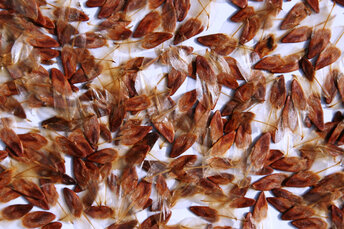 Mature winged seeds from the Drooping Sheoak Mature winged seeds from the Drooping Sheoak Seed collection and propagation If you’re planning to collect the shiny cones for seed, they're not ready. I fell into this ‘trap’ on an early seed collecting expeditions and found the seed from these cones was pale and immature. The cones need to spend a few more months ripening on the tree until they finally turn a weathered grey. Yes, the grey colour of those outside lining boards that needed to get a coat of oil last spring. These weathered cones will open when placed in a paper bag and the dark brown winged seeds will fall to the bottom. Now they’re ready to sow into a seedling tray or direct seed into the back paddock next spring. No seed treatment is needed. If you’re concerned about the genetic diversity of your future sheoak plantation, collect cones from at least ten trees. Also collect from around the perimeter of each tree to allow for pollen blowing in from different directions. The male sheoaks will be so grateful you made this extra effort. Next time you’re driving past some Drooping Sheoaks on the roadside, I hope you’ll notice their graceful beauty and think about their remarkable history. If some are showing signs of yellowing at the tips don’t be concerned, it’s just the males getting ready to spread some cheer around. Hopefully there is a fair wind blowing to carry their pollen to the nearest female trees. This is an age old process that has been happening in Australia for millions of years and should continue for countless years to come if we appreciate and look after this remarkable and resilient local tree.  To read more about Aboriginal culture and the Drooping Sheoak click below to read; 'The vegetation of the Barrabool Hills part 4 - Drooping Sheoaks adorned the hills in 1835'
10 Comments
Dale Smithyman
29/3/2021 03:46:14 pm
Great article Steve!
Reply
Steve
29/3/2021 09:44:21 pm
Dale,
Reply
Lyn Doherty
29/3/2021 08:06:57 pm
Hi Steve,
Reply
Steve
2/4/2021 04:12:10 pm
Thanks for your great feedback Lyn. There is a lot to learn about the Drooping Sheoak because it was such a significant tree for Indigenous Australians
Reply
David
2/4/2021 04:14:34 pm
‘Sheoke’ vs. ‘sheoak’ (or she-oak) – The prefix ‘she-‘ is a hangover from old English, dating back to Saxon times and is used to indicate something that is similar to an existing thing but a lesser or inferior version of that thing. For example, a she-devil is not a female devil, but a lesser or less powerful devil. ‘She-oak’ was coined because the timber was believed to be reminiscent of oak, but inferior to oak. However, in modern times, ‘she’ is universally and frequently used as the pronoun for female things. It is timely to drop the dated and arcane use of ‘she’ as a prefix meaning inferior. ‘Sheoke’ removes both that pejorative meaning for ‘she’ and the use of a name essentially defined & belonging elsewhere. These trees are ours (almost uniquely Australian). We should use words for them that do not refer to elsewhere. After all, ‘goanna’ is a similarly derived word (from Spanish American ‘iguana’) but is now universally used in common parlance in this country, to which more than 2/3 of the world’s species are native.
Glen White
12/4/2021 04:17:30 pm
Hi Steve
Reply
Steve
12/4/2021 04:39:11 pm
Good to hear from you Glen and thanks for sharing your personal experience of the whispering sheoaks. If you had believed that it was your respected ancestors whispering to you, I imagine you would have felt very safe and reassured by the sound.
Reply
Lyhn Barfield
27/8/2021 01:02:28 pm
Hi Steve.....Christine Russell sent me your blog....I do not know who you are but would love to connect to your writings ...how do I do this....we are building in Point Lonsdale and I want to grow a local wild garden naturally there will be drooping sheoaks. It's all the more meaningful to understand the historic story ...I need to learn more ....tx for your time.Also would you mind if I draw some aspects from your blog to tell a bit to the members of Yarra Yarra APS ...so interesting .
Reply
Steve
27/8/2021 04:30:38 pm
Hi Lyhn,
Reply
Luci
26/4/2024 08:48:56 pm
Hi Steve,
Reply
Leave a Reply. |
Click on the image below to discover 'Recreating the Country' the book.
Stephen Murphy is an author, an ecologist and a nurseryman. He has been a designer of natural landscapes for over 30 years. He loves the bush, supports Landcare and is a volunteer helping to conserve local reserves.
He continues to write about ecology, natural history and sustainable biorich landscape design. 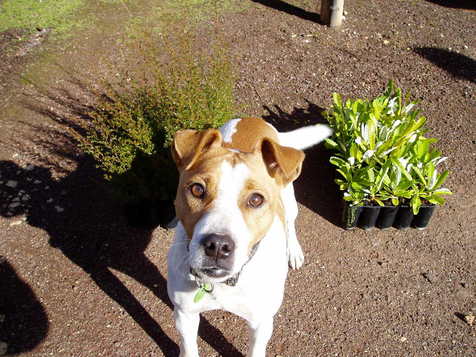
|
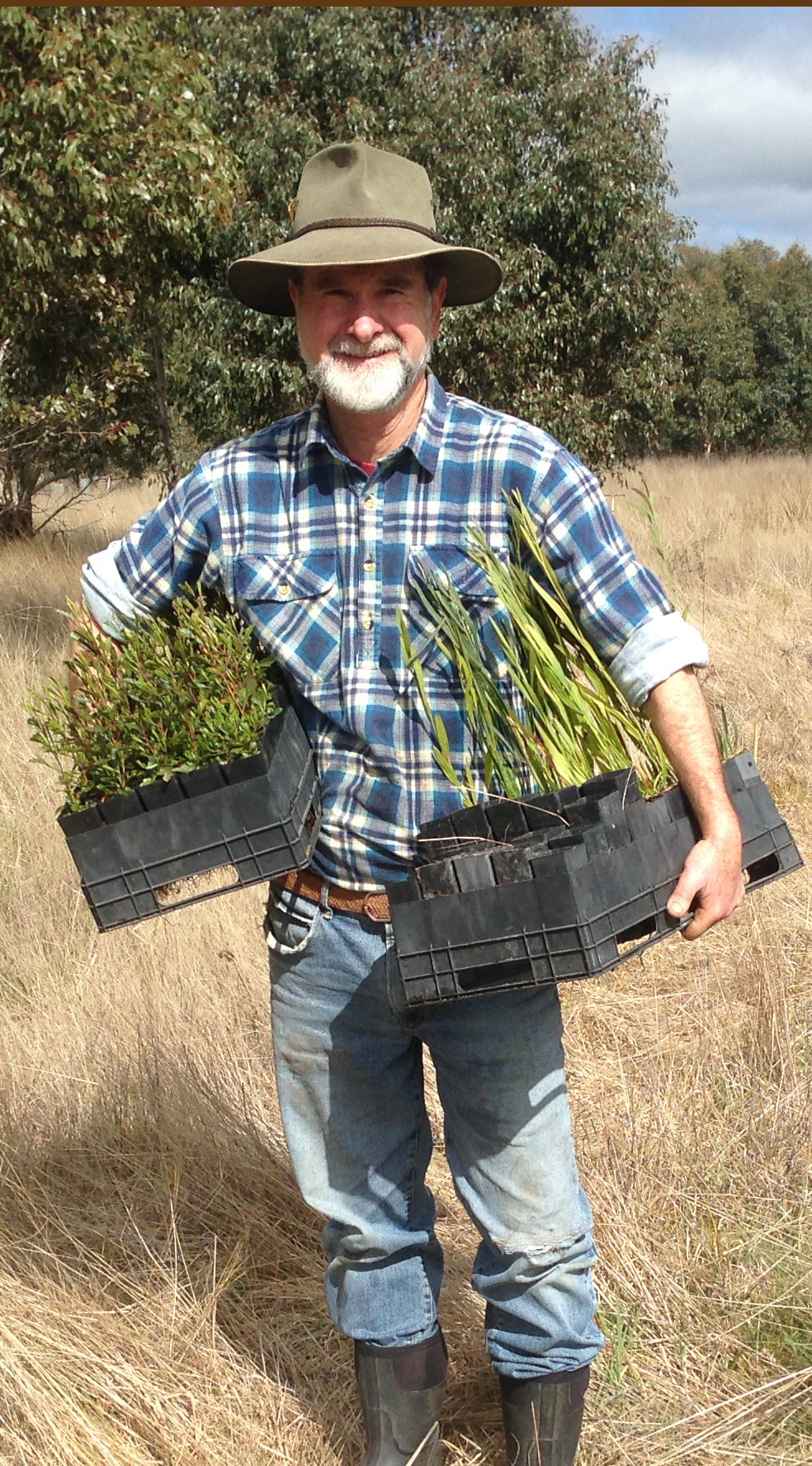

 RSS Feed
RSS Feed
